Remote lighting control: types of systems, equipment selection + installation rules
Properly equipped remote control of lighting makes it possible to correctly turn on and off remote light sources, weaken or enhance the overall intensity of the backlight, and activate emergency light supply devices in case of acute need.
The presence of a "smart" system increases the level of comfort of the room, significantly reduces the consumption of energy resources and allows you to control lighting equipment without being at the facility.
In this article we will tell you how to properly organize the arrangement of remote lighting, about the types of control devices and the rules for self-installation of remote control systems.
The content of the article:
Classification of Remote Control Devices
Remote lighting control systems automatic, semi-automatic and tame.
The former most effectively manifest themselves in large-sized residential cottages, buildings and structures, in large areas and large-scale adjoining territories.
Through an intelligent controller, they are connected to a computer and programmed to perform tasks of any complexity. They are expensive, but take full control of the lighting at the facility.

Semi-automatic systems work well in private households where it is not necessary to control a large number of light sources.
Manual options provide for remote control of one or a group of lighting devices using a remote control or controller.Installation of such modules is very simple and does not require the participation of narrow-profile specialists.
Let us consider in more detail each of the options.
View # 1 - automatic control equipment
The main task of automatic complexes (ASUO) is to provide energy-efficient lighting in residential and working buildings.
The hardware-software complex not only controls the timely activation and deactivation of light flow, but also implements a progressive algorithm Daylight.
This allows you to continuously maintain indoor lighting level that meets generally accepted basic standards.
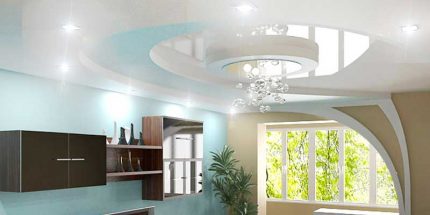
Remote systems designed for automatic control of lighting devices and elements are divided into two main classes:
- local
- centralized.
Local-type equipment controls one group of fixtures. The centralized complex allows you to connect an unlimited number of separately controlled light sources to the communication node.
Local control systems. Local control units are placed in small-sized, compact cases and are mounted directly on the lamp or lamp bulb.
Sensors that capture the signal are a single electronic communicator, built into the system.

Remote control devices of a local type are divided into two groups. The first includes control units for certain lighting fixtures, the second includes complexes that regulate the level of lighting of the entire room as a whole.
Centralized automatic system. The centralized control equipment is based on microprocessors capable of simultaneously regulating the full-fledged operation of several hundred light sources.
Communicators with this configuration not only manage the process of lighting the premises, but also competently interact with telephone networks, fire alarms and other engineering systems (security and safety, ventilation, chimney, air conditioning and heating).
Additionally, centralized-type complexes pick up the signals of local sensors and supply control pulses to illuminated devices under control.
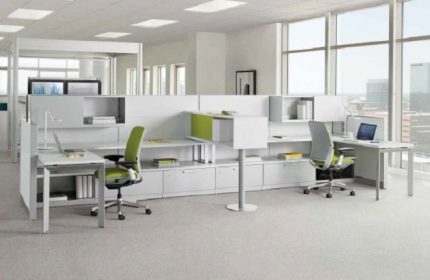
Processing and conversion of signaling information takes place within a single node.
This opens up great opportunities for manual control of lighting in buildings of any scale and greatly simplifies the introduction of necessary changes to the basic algorithm of the light supply system.
View # 2 - semi-automatic control option
Semi-automatic control systems are a block with several toggle switches, built into a switchboard.
They are programmed to activate and deactivate lighting in certain rooms and areas of the house territory at a time convenient for the owners. They do not provide for connection to the control system of all residential premises, work buildings and parts of the adjacent plot.
View # 3 - hand-held devices for lighting control
Manually remotely turn on and off the light allow special remotes.
According to the type of signal, they are divided into two groups:
- radio-controlled;
- infrared (IR).
Radio controlled. Devices on radio waves do not clog the ether during operation and correctly send a signal to a light source that is outside the zone of direct visibility.
The basic range of devices is about 100 m, however, this figure is 3-4 times lower if there are natural obstacles in the room or in the adjacent area.
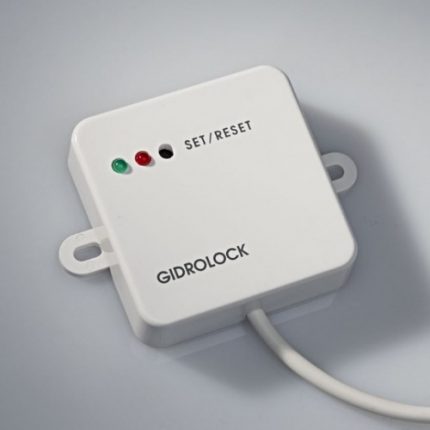
Group of IR devices. The infrared device works reliably and clearly transmits commands, but only in the line of sight.
It has a small radius of influence and sends a pulse to a distance not exceeding 12 meters in the presence of a powerful transmitter.
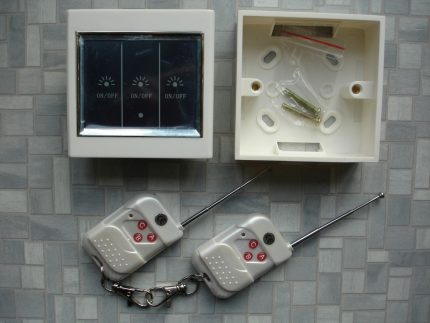
On standard infrared-type manipulators, there are 5 to 7 buttons programmed for a specific action.
Radio wave devices have 7-10 buttons that can control not one device, but a configured group. For example, in one click activate the lighting on the parking area and at the same time open the gate to enter the car.
Equipment for the control complex
The lighting control complex is a multifunctional communication node with wide optional capabilities.
It integrates lighting devices, sensors, photocells and other auxiliary devices into a single intelligent system.
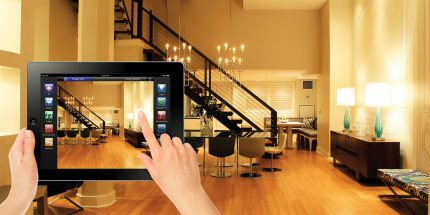
If necessary, the network works completely independently in the established mode and does not require constant user participation.
Additionally, the complex may include:
- circuit breakers with the option of self-activation and deactivation;
- dimmersable to automatically adjust the power level of light flow in closed rooms and open locations in automatic mode;
- lamps with expanded functionality - automatic inclusion and switching off, increase or decrease of power, change of color temperature and a shade of the given light;
- led strip with additional options and RGB-type controllers;
- motion sensors, light, presence in the room, opening doors and windows;
- remote switches.
Correctly configured control equipment works stably and correctly interacts with fire alarms, HVAC and other indoor systems.
Control units represent communication nodes with buttons on the case panel and carry out the correct switching on and off of lighting devices.
Some models control the intensity of the flow of light and its brightness, have the ability to receive and process signals from remote controls. The block buttons are independently programmed for certain actions.

Controllers relate to simplified elements of remote control lighting networks.
They are made in the wall version and are usually mounted at the entrance to the room.Remotely activate and deactivate lighting devices according to the established program.
Initially, the manufacturer adjusts the module to the standard functioning algorithm. You can make changes to the operating mode through the connected LCD display and keyboard.
The program starts to act, receiving a signal from sensors, timers, remote control or by manually pressing buttons on the body of the controller itself.
RGB-type controllers are used for remote control of LED strips.
They have wider functionality and regulate such parameters as:
- on / off;
- lighting brightness;
- glow range.
Using these control elements, you can change the tonality of the light flow, adjusting it to the situation or mood.
Sensors relate to auxiliary elements of the monitoring system and respond to changes in certain parameters.
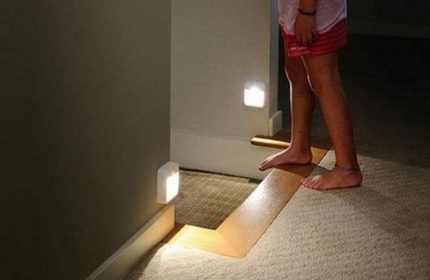
Motion-sensing modules activate light when a user enters a room, and turn off lights when the room is empty. This makes it possible to use energy efficiently and not to pay big money on utility bills.
Light level sensors are most useful in outdoor systems. They promptly turn on the light in the adjoining territory when dusk sets in on the street, and quickly turn it off at sunrise.
This method of remote control allows you to save electricity and reduce the operational load on street lighting devices.
Time relays and timers make it possible to control the lighting according to a specific schedule. The user can set the required interval for turning the equipment on and off.
Read how to connect a time relay. Further.
Individual device models are equipped with a microprocessor and are subject to programming for specific tasks.

Photocells control the natural light of the room or open area.
With a decrease in the level of light flux, artificial light supply is activated and its intensity is intensified as needed. They do not respond to sudden bright flashes and take into account only the general background of illumination.
Lighting Control Guidelines
The selection of suitable elements for organizing a lighting control system directly depends on the object that needs to be taken under control.
It is necessary to buy components only in specialized stores, giving preference to products of trademarks and brands that have worked well in the market.
The subtleties of organizing a control system in an apartment
For a standard city apartment, the installation of the system is advisable in the presence of multi-tiered internal lighting.
A chandelier, wall sconces, ceiling lights and other light sources available in the room are connected to the control unit. Full or partial activation / deactivation of lighting devices is carried out through the remote control type.

In sanitary rooms, it is more reasonable to install motion sensors. Then the light in these rooms will turn on only at the time of the visit, and turn off 1 minute after the user leaves.
Tips for Cottage Owners
A small private house with a minimal adjoining territory should be equipped with a semi-automatic lighting control system.This will not require large expenses, but will increase the comfort of living.
The module can connect a spotlight above the entrance gate, lights along the path to the house, lamps in the hallway and living room.

In large-sized cottages with a large adjoining territory, automatic remote control systems, which include not only basic components, but also additional sensors, timers, dimmers and controllers, are most effective.
The presence of such elements allows you to control every aspect of the lighting, not only indoors, but throughout the surrounding area.
The main advantages of control systems
Initially, the ability to remotely control lighting was available only in expensive and advanced systems. "smart House". Now the situation has changed and the function has begun to be implemented in simpler control complexes and blocks.
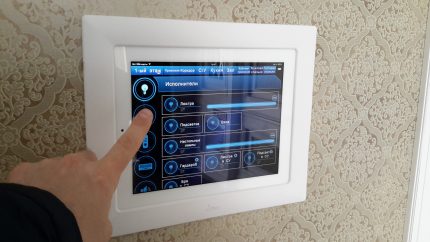
Remote equipment has many useful qualities and advantages.
Among the main advantages are the following important positions:
- Ensuring the safety of the premises in the absence of owners. System management is available through any modern gadget with Internet access. Property owners, going on a business trip or vacation, can program an automatic on / off light that simulates the presence of tenants in a house or apartment.
- Saving money and materials during installation. To install the simplest remote control system, you do not need to buy a cable, hire workers for wall gating and spend additional funds in the future on replacing wires.
- Independence from power surges and blackouts electricity. In many progressive control complexes, a cabinet, an automaton and a touch switch with a remote control contact through radio waves and do not require the availability of energy in the network.
- Financial feasibility. Remote control units allow the most efficient use of electricity and illuminate at any given moment only the necessary objects, premises and territories. With this approach, the efficiency of the lighting system increases, and energy consumption drops without compromising the comfort of the property owners.
These parameters make the system relevant and popular technical solution for remote control of lighting equipment.
Rules for self-installation
Local and centralized remote control systems are integrated into the electrical wiring available at the facility. The supply of circuits with a working resource from lines supplying electricity for lighting devices is allowed in this case.
The role of the circuit breakers is played by switches that respond to the signal.
The “sophisticated” control modules have advanced functionality and have the ability to change internal network indicators, disconnect individual zones from lighting and leave the optimal level lighting only in those rooms where it is appropriate at a particular time.

Self-installation of the remote control system at home is permissible.
But for this, it is necessary to observe the basic fire safety rules and perform the following steps in the indicated sequence:
- Disconnect power to the room through the flap and install a warning sign for ongoing work.
- Carefully dismantle obsolete push-button switches using a profile tool.
- On the vacant places, place multifunctional electronic devices equipped with a receiver, a signal decoder and a breaker.
- Reliably isolate the contact area between the network wires and the working board of the remote control unit.
- Activate the supply of electric current and carefully test all elements of the control system for serviceability and performance.
- If no problems are found, proceed with operation.
In the absence of practical experience with electrical devices, you should not tackle the matter yourself. It is better to use the services of professionals and instruct them to install control equipment.
Conclusions and useful video on the topic
Features of the remote control module for street lighting. Detailed review and testing of device functionality.
How to control the interior lighting in the apartment using the remote control.
Lighting control in residential areas via relays.
A progressive control system for indoor and outdoor lighting provides the ability to control all parameters of the light flux. For ordinary city apartments, a device with a remote control is best suited.
In large facilities and in large cottages with a large adjoining territory, the automatic complex demonstrates maximum efficiency. The first version of the equipment (with remote control) is easily mounted independently.
Installation of the second requires specific knowledge and narrow-profile experience. The work of this level is best entrusted to professional electrical engineers.

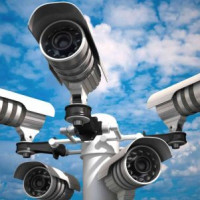 Installation of CCTV cameras: types of cameras, selection + installation and connection do-it-yourself
Installation of CCTV cameras: types of cameras, selection + installation and connection do-it-yourself  DIY video surveillance for a private house: design + installation rules
DIY video surveillance for a private house: design + installation rules 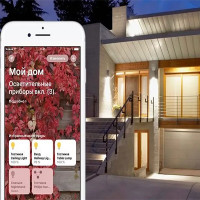 Apple smart home: the intricacies of organizing home control systems from the apple company
Apple smart home: the intricacies of organizing home control systems from the apple company  Climate control for home and apartment: device and system advantages + subtleties of choice and installation
Climate control for home and apartment: device and system advantages + subtleties of choice and installation 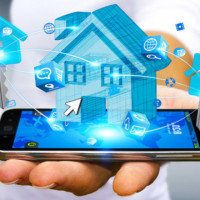 The Smart Home system for a country house: advanced devices for automatic control
The Smart Home system for a country house: advanced devices for automatic control 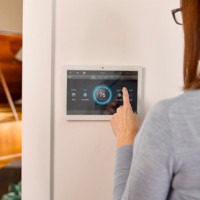 Heating in a smart home: device and principle of operation + tips for organizing a smart system
Heating in a smart home: device and principle of operation + tips for organizing a smart system  How much does it cost to connect gas to a private house: the price of organizing gas supply
How much does it cost to connect gas to a private house: the price of organizing gas supply  The best washing machines with dryer: model rating and customer tips
The best washing machines with dryer: model rating and customer tips  What is the color temperature of light and the nuances of choosing the temperature of the lamps to suit your needs
What is the color temperature of light and the nuances of choosing the temperature of the lamps to suit your needs  Replacement of a geyser in an apartment: replacement paperwork + basic norms and requirements
Replacement of a geyser in an apartment: replacement paperwork + basic norms and requirements
I live in a multi-storey building, and still we do not have smart lighting. It really saves light. We plan to put in our high-rise building electric lighting with sensors for movement in the entrance on each floor. We will not mount it on our own, we have already invited electricians. My own apartment is being renovated when we install multi-tiered interior lighting, and install a lighting control system through a DU-type remote control.
For their home, they chose a semi-automatic lighting control system. The area of the house and the surrounding area is small. A lot of money was spent on equipment and installation. But now lighting control has become much more convenient. Honestly, I myself do not understand anything in electricity, therefore, they did not take risks, they turned to electricians.